If you’re like most cichlid enthusiasts, you probably want to keep a few different species of cichlids in your aquarium.
Unfortunately, not all cichlids can be kept in a community tank. In fact, many cichlids are quite aggressive and will fight with other fish, including other cichlids, which makes it hard to find good cichlid tank mates.
So, how do you choose the best cichlid tank mates? In this article, we’ll discuss the best cichlid tank mates and how to choose them.
What Makes the Ideal Cichlid Tank Mates?
Cichlids are a diverse group of fish that come in all shapes, sizes, and colors. They’re native to freshwater lakes, rivers, and streams in Africa, Central America, and South America and are known for their aggressive behavior, which is often the result of competition for food and space.
When choosing cichlid tank mates, it’s important to consider the following factors:
Type of Cichlid
The main factor that affects what tank mates you can choose for your cichlid tank is the type of cichlid you have. There are many different types of cichlids, and not all of them can be kept together or with other fish.
Cichlids are typically classified into two main types: American Cichlids, also known as New World Cichlids, and African Cichlids, also known as Old World Cichlids.
These two differ in appearance, behavior, and habitat, so you must be familiar with them first to fulfill their tank requirements.
Fish Size
The size of your cichlid will also play a role in choosing tank mates. Cichlids come in a wide range of sizes, from the tiny dwarf cichlid to the massive Boulengerochromis cichlid.
You don’t want to pair a small cichlid with a much larger fish because the larger fish may view the cichlid as food.
Likewise, you don’t want to pair a large cichlid with a much smaller fish because the small fish may become stressed or intimidated by the large cichlid.
Temperament
Although cichlids can be kept in a tank with other fish, choosing tank mates with a similar temperament is critical.
Cichlids, in general, can be rather hostile. If you don’t choose tank mates that can hold their own during a fight, you’re likely to end up with injured or dead fish.
Additionally, African cichlids are typically more aggressive than American cichlids, which means they’re less likely to do well with other fish. That’s why many African cichlids have to be kept in single-species tanks.
Tank Size
Another important factor to consider when choosing cichlid tank mates is the size of your tank. Cichlids need a lot of space, and if you have a small tank, you won’t be able to keep as many fish.
At the very minimum, most cichlids need at least a 55-gallon tank. If you want to have tank mates for them, you need to get a bigger tank than this.
Water Parameters
Different species have different requirements when it comes to water parameters. For example, some prefer soft water, while others prefer hard water.
When choosing the ideal cichlid tank mates, make sure they have similar water parameter requirements to avoid potential health problems down the road.
Best African Cichlid Tank Mates
African Cichlids are notorious for their aggressive behavior. As mentioned earlier, this makes it hard to house them with other fish.
However, there are some African cichlids you can keep with other fish as long as they are of a similar size and temperament.
African Red-Eyed Tetra
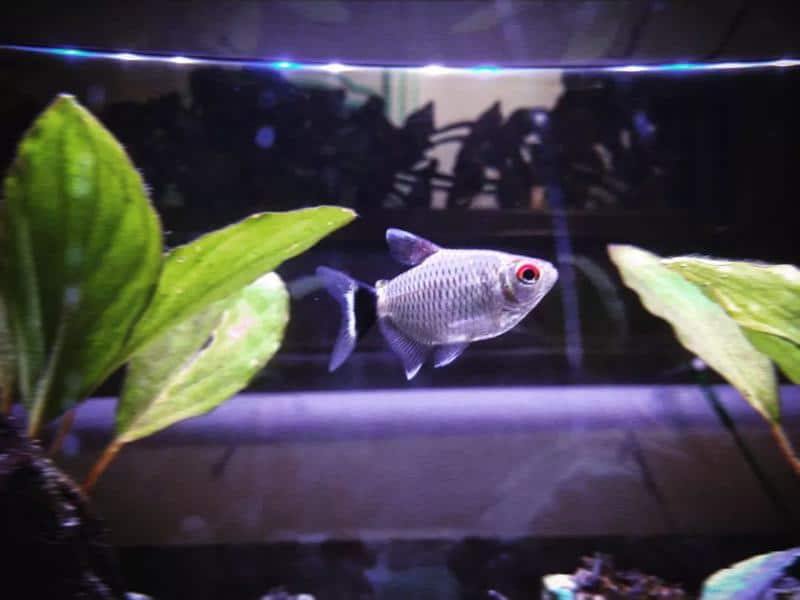
- Scientific Name: Moenkhausia sanctaefilomenae
- Temperament: Peaceful
- Size: 2-4 inches (5-10 cm)
The African Red-Eyed Tetra is a relatively large variety of Tetra that makes an excellent tankmate for cichlids for several reasons.
First of all, African Red-Eyed Tetras are big enough not to fall prey to most African Cichlid species. They also have similar water parameter requirements to African cichlids, and, most importantly, they’re peaceful fish that won’t start fights with cichlids.
That said, since they’re quite big, they do need plenty of room to swim. Additionally, they thrive best in tank environments that resemble their natural habitat, so make sure you add as many stones, plants, and wood to the tank as possible.
Zebra Loach
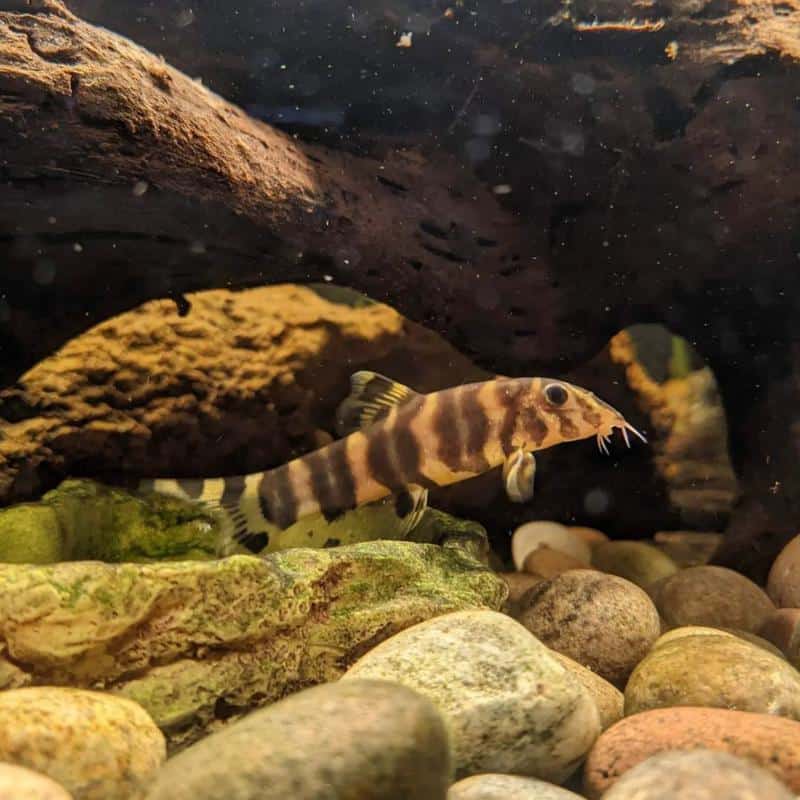
- Scientific Name: Botia striata
- Temperament: Peaceful
- Size: 8-4 inches (7-10 cm)
The Zebra Loach is another excellent tankmate for cichlids. These are just the right size, making them less likely to be eaten by cichlids. They’re also peaceful fish that won’t start fights.
Plus, they have similar water parameter requirements to cichlids, and they’re known to be good at helping to keep the tank clean.
The only downside to Zebra Loaches is they require a lot of hiding places in the tank, so you need plenty of plants and wood for them to hide in. And since they like to forage in the substrate, you should choose hardy plants with dense root systems so that the fish don’t uproot them.
Giant Danios
- Scientific Name: Devario aequipinnatus
- Temperament: Peaceful
- Size: 5-6 inches (12-15 cm)
Giant Danios are another excellent choice for cichlid tank mates for the same reasons as the African Red-Eyed Tetra.
These schooling fish from the minnow family can act as “dither fish” for your cichlid tank. Dithers refer to smaller fish whose behavior can be used by cichlids to gauge whether they’re in danger or not, thus reducing stress, anxiety, and aggression.
Due to their size, it’s unlikely that cichlids will try to eat them. These two species also don’t interact much since Danios are known to frequent the upper-middle levels of the aquarium.
Like other Danio species, Giant Danios enjoy densely planted tanks, where they often hide and play.
Red-Tail Shark
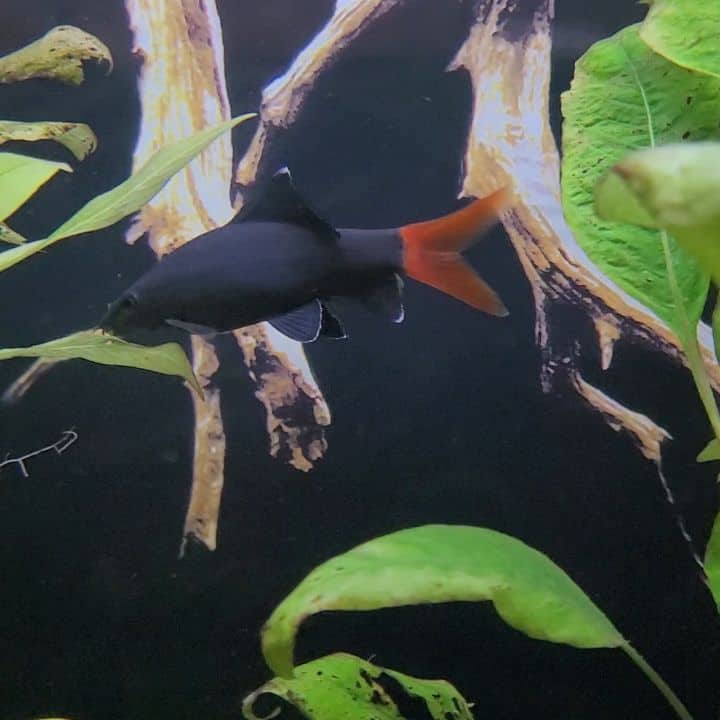
- Scientific Name: Epalzeorhynchos bicolor
- Temperament: Semi-Aggressive
- Size: 4-6 inches (10-15 cm)
The Red-Tail Shark is a semi-aggressive fish with similar tank requirements as African Cichlids. It gets its name from its red tail fin and pure black body.
Red-Tail Sharks like establishing their own territory in the tank. They prefer rocky aquascapes with dense foliage, which allows them to hide and destress.
That said, make sure you only keep one in your aquarium since they dislike tank mates that look similar to them. Also, opt for pebble or gravel substrate, as sand can scratch and irritate their lower belly.
Leopard Bush Fish
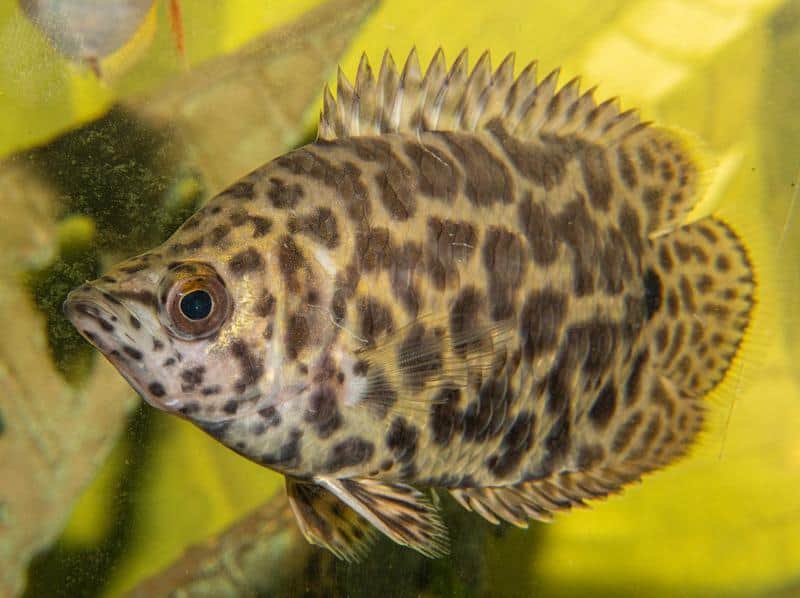
- Scientific Name: Ctenopoma acutirostre
- Temperament: Peaceful
- Size: 6-8 inches (15-20 cm)
The Leopard Bush Fish is an interesting cichlid tankmate from the African continent, particularly the Congo basin.
Its body is entirely covered with striking black and yellow spots, making it a very attractive addition to cichlid tanks.
Leopard Bush Fish are carnivores that use their mimicry skills to stalk and ambush their prey. They can present like dried leaves in the water before attacking unsuspecting invertebrates and smaller fish.
Plecostomus
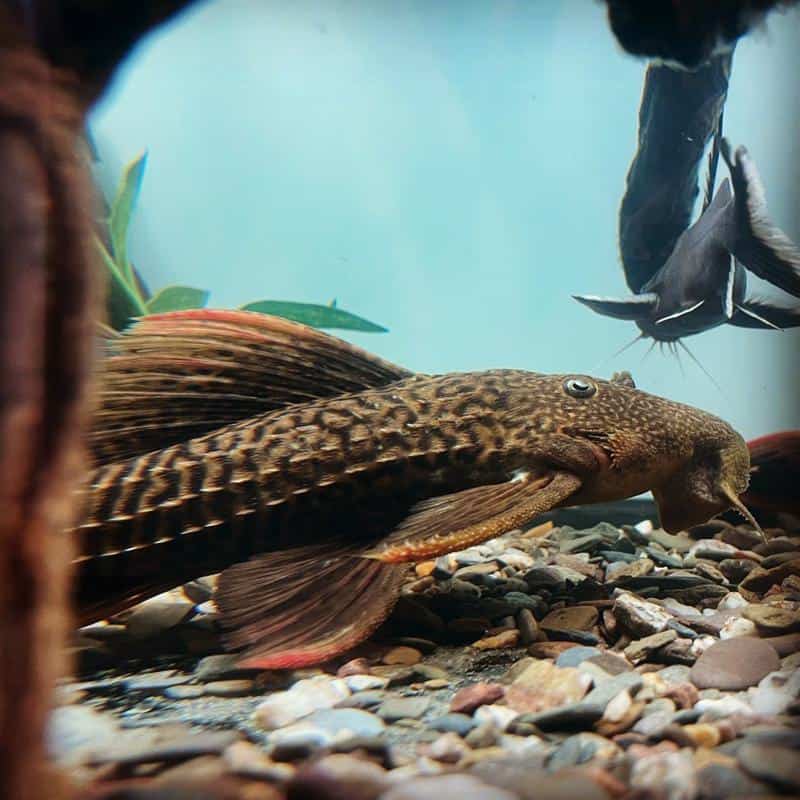
- Scientific Name: Plectorhinchus spp.
- Temperament: Peaceful
- Size: 11-12 inches (28-30 cm)
Plecostomus, also known as plecos, are a type of armored catfish that are native to South America. There are many different species of plecos, but the most popular one for aquariums is the Common Pleco.
Plecos make amazing tank mates for cichlids because they’re peaceful bottom-dwelling fish that help clean the tank. They eat algae and other debris off the aquarium walls and decorations, ensuring the tank stays clean and looks good.
Plecos are also nocturnal fish, so they’ll only be active when cichlids are asleep. In the morning, you can typically find them hanging out under rocks and other hiding places.
Other Cichlids
There’s one more fish that African Cichlids can make great tank mates: other African cichlids.
African cichlids are social fish, and they’ll often form hierarchies within their tank. If there are other cichlids in the tank, they will establish these hierarchies with them as well.
That said, not all African cichlids can be kept with other cichlids. Some cichlid species are too aggressive towards others, so it’s best to do some research on cichlid compatibility before adding any new cichlids to the tank.
For example, Electric Yellows (Labidochromis caeruleus) are a Malawi cichlid known to be pretty peaceful, at least as far as African cichlids go. Many aquarists have managed to successfully house them with other cichlids like Peacock cichlids (Cichla ocellaris), Zebra cichlids (Amatitlania nigrofasciata), and Blue Acara cichlids (Andinoacara pulcher).
However, Malawi cichlids from the Maylandia and Melanochromis genera tend to be more aggressive than others, so they’re best kept in a single-species tank. The same goes for the Duboisi Cichlids (Tropheus duboisi), the most aggressive cichlids found in Lake Tanganyika.
When in doubt, err on the side of caution, and don’t add cichlids to the tank you’re unsure about.
Additionally, even if you have two compatible species, you need to make sure you have a large enough tank to hold all of them. Cichlids tend to fight over territory, you need to give them enough space to allow them to establish their own.
Best American Cichlid Tank Mates
The continent of America is also home to many species of cichlids, particularly in Central and South America.
American cichlids are typically less aggressive than African cichlids, making them better candidates for community tanks.
That said, there is still a wide range of temperaments within the American cichlid group. In fact, although there are more African species that are known to be aggressive, the most aggressive cichlid species in the world are endemic to Central America.
This is why you need to do some research before introducing new cichlids into the tank.
Rainbowfish
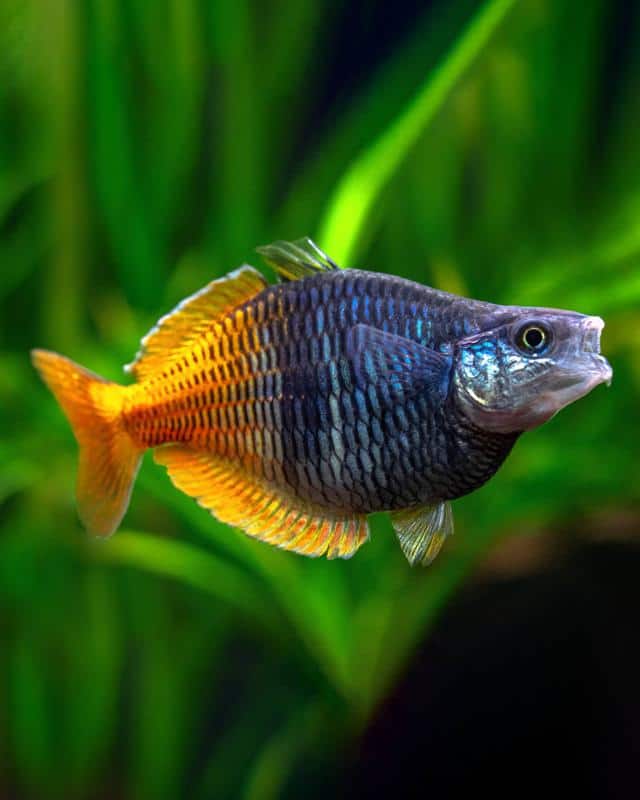
- Scientific Name: Melanotaeniidae sp.
- Temperament: Peaceful
- Size: 2-4 inches (5-10 cm)
Rainbowfish are a group of beautiful, shoaling fish that can be housed with American cichlids. They have a peaceful temperament and come in an array of colors, including metallic blues, greens, and even reds.
Rainbowfish are shoaling fish, so they need to be kept in groups of at least 6-8 individuals. They like planted tanks but will also need open water areas. Since they’re active swimmers, they need a large space to swim and play to their hearts’ content.
It’s important to note that not all Rainbowfish species can be housed with cichlids. Compatible species include Murray River Angelfish, also known as Australian Angelfish, Salmon Red Rainbowfish, also known as New Guinea Rainbowfish, and Boesemani Rainbowfish.
Related: Australian Rainbow Fish
Silver Dollar Fish
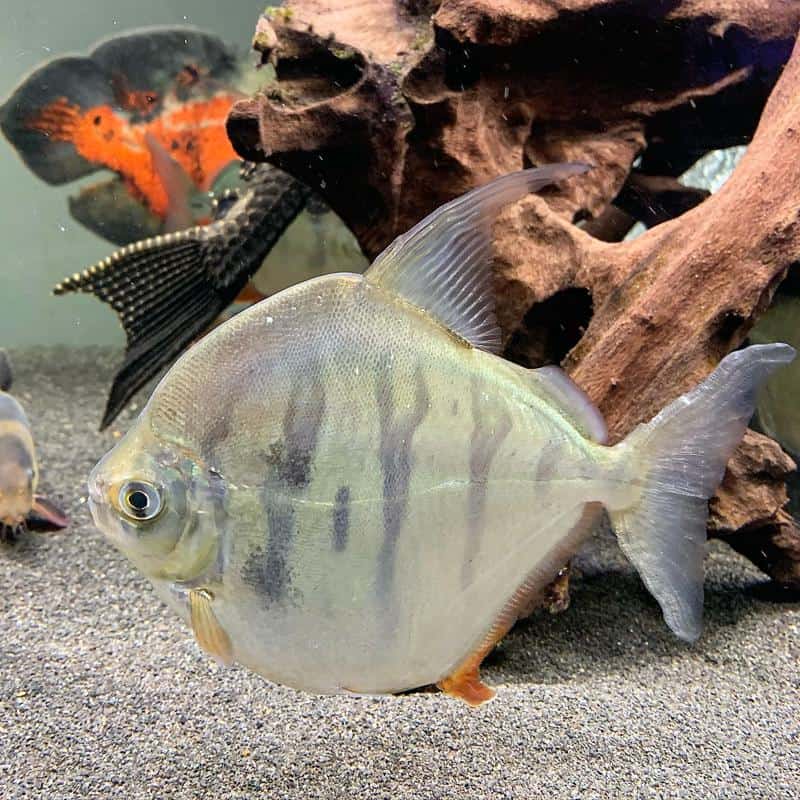
- Scientific Name: Metynnis spp.
- Temperament: Peaceful
- Size: 3-4 inches (8-10 cm)
Silver Dollars are another great cichlid tankmate. They’re native to the freshwater rivers of South America and have a peaceful temperament.
Appearance-wise, Silver Dollars have a silver-gray coloration, with a few darker scales scattered throughout. They also have a rounded shape, hence their name.
Silver Dollars are schooling fish, so they need to be kept in groups of at least 5-7 individuals. Like many other active schooling fish, they like planted tanks with plenty of hiding spots and open water areas to swim.
The Silver Dollar can thrive in a large tank with mid-sized cichlids. Larger cichlids like Oscars (Astronotus ocellatus) may be too aggressive, so it’s best to avoid them.
Clown Loach
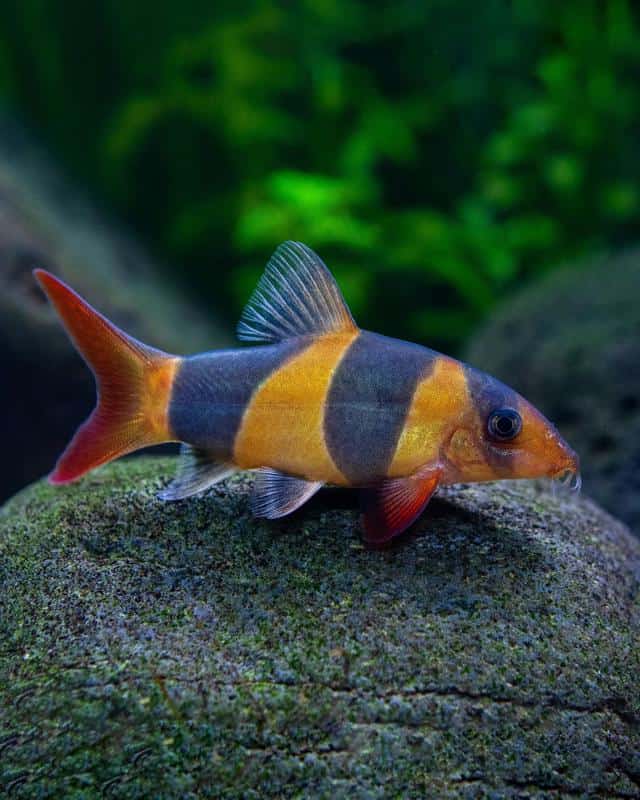
- Scientific Name: Chromobotia macracanthus
- Temperament: Peaceful
- Typical Size: 6-8 inches (15-20 cm)
Clown loaches are peaceful bottom dwellers that make great Central and South American cichlid tank mates. They mostly keep to themselves, rarely interacting with other fish.
With clown loaches, you can be sure that your substrate is always clean and aerated. They’re active diggers and often forage for food on the bottom of the tank. They also like playing hide-and-seek, so there should be lots of hiding spots around.
Clown loaches are social fish and need to be kept in groups of at least three individuals. They can reach up to 12 inches in length, so make sure you have a large enough tank to house them. As long as they have enough space, they’ll get along with cichlids just fine.
Corydoras Catfish
- Scientific Name: Corydoras spp.
- Temperament: Peaceful
- Typical Size: 2-4 inches (5-10 cm)
Corydoras catfish are endemic to South America, which means they share the same environment as American cichlids. They’re small, placid bottom dwellers that get along well with other tank mates, including cichlids.
Although Cories are often active during the day, they’ve been observed to sit motionless for extended periods of time. In case they feel like doing this, you should have enough hiding places in your cichlid tank, like caves, driftwood, and rocks, for them to feel safe and secure.
Corydoras catfish are schooling fish and need to be kept in groups of at least six individuals. They do best in tanks with sandy substrates since harder or bigger substrates can hurt their undersides.
Barbs
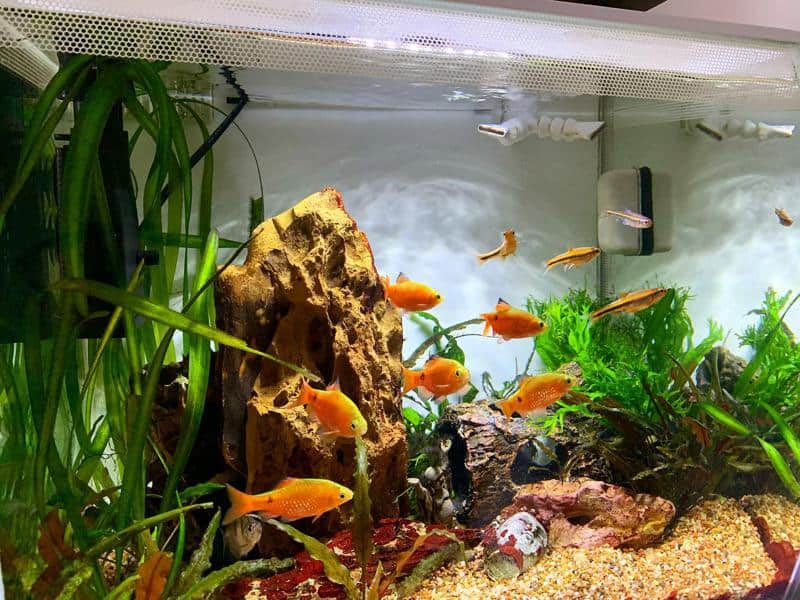
- Scientific Name: Barbus spp.
- Temperament: Peaceful
- Size: 2-6 inches (5-15 cm)
Barbs are another group of fish that can be housed with smaller and less aggressive American cichlids. They’re native to Asia, Africa, and some parts of Europe, but they’ve also been introduced to the waters of Central and South America.
Barbs come in a wide variety of shapes, sizes, and colors. They’re active fish that need plenty of open space to swim and play. Most species are peaceful, although some can be a bit nippy with long-finned tank mates.
Not all Barbs can be kept with cichlids, though. Tiger Barbs, for instance, are too active and can harass cichlids. Cherry Barbs (Puntius titteya), Tinfoil Barbs (B. schwanenfeldii), and Rosy Barbs (Puntius conchonius), on the other hand, are quite peaceful and make good cichlid tank mates.
That said, Cherry Barbs are quite small and can easily get eaten by larger cichlids, so they should only be housed with Dwarf Cichlids.
Blue-Eyed Panaque
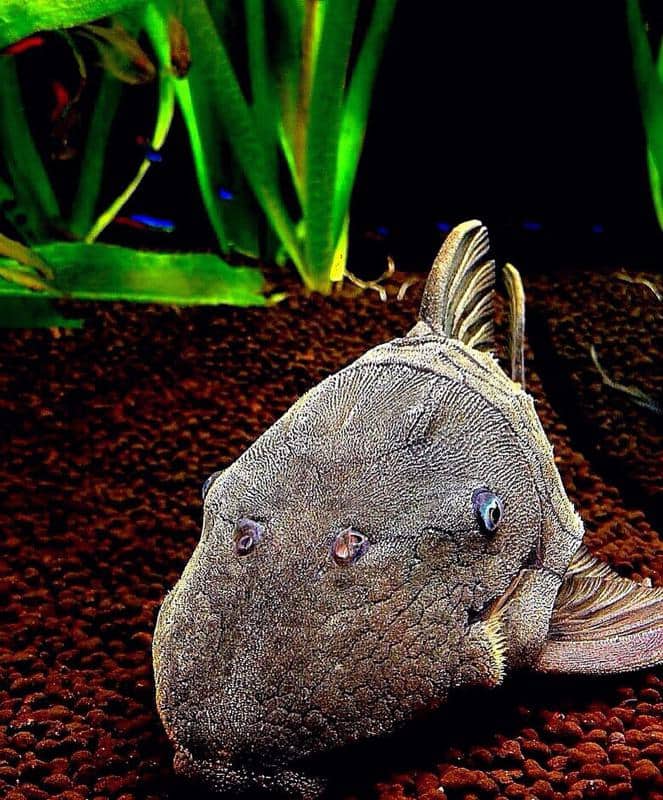
- Scientific Name: Panaque cochliodon
- Temperament: Peaceful
- Size: 8-12 inches (20-30 cm)
The Blue-Eyed Panaque, also known as the Blue-Eyed Plec, is a South American catfish that makes an excellent cichlid tankmate. It has a peaceful demeanor and is not aggressive like most cichlids.
The Blue-Eyed Panaque has a unique look due to its striking blue eyes, which scientists think is because of its low-visibility natural habitat. They’re also unique because they have teeth in their lips, which allows them to feed on wood and other hard surfaces.
Unfortunately, their population has been decreasing due to several factors, such as pollution, habitat destruction, and overfishing.
Mexican Tetra
- Scientific Name: Astyanax mexicanus
- Temperament: Peaceful
- Size:5-3 inches (4-8 cm)
The Mexican Tetra is a small, peaceful fish native to Mexico and Central America. Like Danios, they can also serve as dither fish for cichlids.
One interesting about them is they have a subgroup that’s completely blind. Due to all their time spent in the dark, the bodies of cave-dwelling Mexican Tetras evolved to conserve energy.This resulted in them losing something they don’t need to survive in pitch black: their eyes.
Nevertheless, Mexican Tetras are not territorial and usually get along with cichlids just fine, although more aggressive species may harass them. Luckily, they’re incredibly fast swimmers and can easily outswim most cichlids, which helps them avoid any potential conflicts.
Keep in mind that Mexican Tetras are schooling fish and need to be kept in groups of at least six individuals. They prefer dimly lit tanks with plenty of hiding places and densely planted areas.
Angelfish
- Scientific Name: Pterophyllum spp.
- Temperament: Semi-aggressive
- Size: 6-8 inches (15-20 cm)
Although there are dozens of Angelfish species known today, only three of them are freshwater – and they make some of the best tank mates for non-aggressive cichlids.
Angelfish, also cichlids, have an elegant, triangular shape and can come in various colors. They have a semi-aggressive temperament and can get along with peaceful cichlids that are of similar size or smaller than them.
When keeping Angelfish with other American cichlids, it’s important to provide plenty of hiding places and open swimming areas. They prefer planted tanks with plenty of vegetation, as well as cichlid-friendly decorations like rocks and driftwood.
Keep in mind that freshwater Angelfish sizes can range from small to large, depending on their specific species. The largest is the Altum Angelfish, while the smallest is the Leopold’s Angelfish (Pterophyllum leopoldi), also known as Dwarf Angelfish. If you have large cichlids, putting them in a tank with Dwarf Angels is a bad idea.
Also Read: Best Angelfish Tank Size: Ideal Tank Size Chart
Other Cichlids
Just like African cichlids, American cichlids can be kept with other cichlid species as well.
Take note that if you want to house cichlids with cichlids, it’s best to select species that come from the same area. Although there are some African cichlids that can be kept with American cichlids, this isn’t generally recommended because they’re used to different water conditions.
For example, cichlids from Lake Malawi are used to hard and alkaline water, while cichlids from the Amazon basin thrive in soft and acidic waters. As such, it’s best to stick with cichlids from the same region to reduce the chances of incompatibility.
If you plan on mixing cichlid species, it’s also important to choose cichlids that have similar temperaments and won’t fight each other, regardless if they come from the same region.
For example, Ram cichlids (Mikrogeophagus spp.) from Venezuela are generally peaceful, while Jack Dempseys (Rocio octofasciata), endemic to Mexico, can be quite aggressive. This means you’re better off housing Bolivian Rams (Mikrogeophagus Altispinosus) with your Angelfish than with Jack Dempseys, even if they all come from the same place.
Ultimately, cichlid tank mates can make for an interesting and engaging tank. Just remember to give cichlids enough room to establish their territories, provide plenty of hiding places, and choose cichlids with similar water parameters and temperaments. Doing so will help ensure that all cichlid tank mates can get along and thrive.
Best Dwarf Cichlid Tank Mates
Dwarf cichlids are a type of cichlid that stay relatively small, typically only reaching about 2-3 inches in size. Due to their small size, dwarf cichlids can be kept with a wide variety of fish that you normally wouldn’t put in a regular cichlid tank.
Cherry Barbs
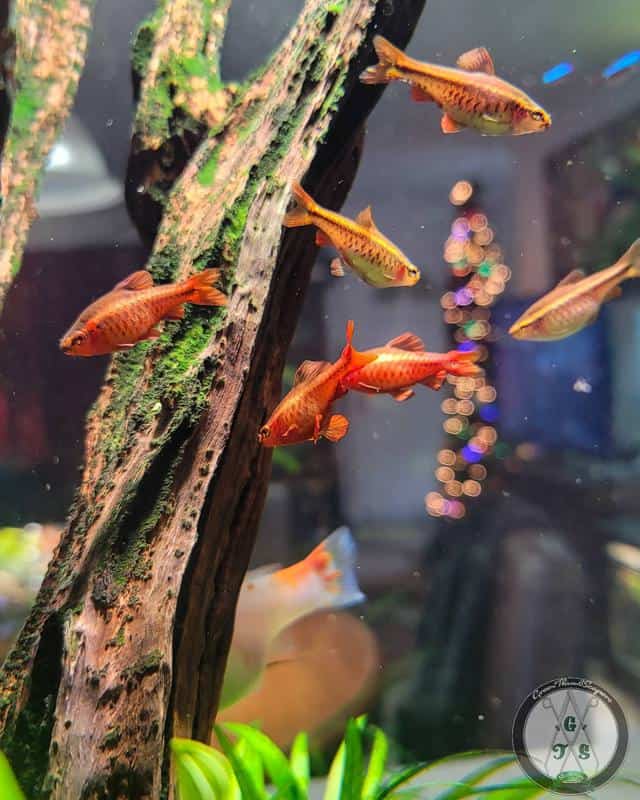
- Scientific Name: Puntius titteya
- Temperament: Peaceful
- Size: 2-3 inches (5-8 cm)
Cherry Barbs are small, peaceful fish that come from Sri Lanka and make a great addition to cichlid tanks. They’re known for their vibrant red and black stripes, earning them their name.
They usually stay rather small, typically reaching only 2-3 inches in size, so they won’t out-compete any Dwarf cichlids for food or territory.
Like other Barb species, Cherry Barbs are also schooling fish, so they should be kept in groups of at least six individuals. They do best in tanks with plenty of vegetation and open swimming areas.
Tetras
- Scientific Name: Characidae spp.
- Temperament: Peaceful
- Size: 2-3 inches (5-8 cm)
Tetras are another peaceful schooling fish that deserves a spot on our list. They’re usually not recommended in most cichlid tanks for two main reasons. One, many Tetra species have the tendency to fin-nip. And two, they’re so small that most mid to large-sized cichlids can easily gobble them up.
Luckily, they still make great tank mates to Dwarf cichlids like Rams and Apistogramma.
Similar to Cherry Barbs, Tetras also prefer planted tanks with plenty of hiding places and open swimming areas. They should also be kept in groups of six or more individuals.
Guppies
- Scientific Name: Poecilia reticulata
- Temperament: Peaceful
- Size: 1-2 inches (2-5 cm)
Guppies are popular for their vibrant colors and peaceful temperament. They’re great cichlid tank mates since they stay relatively small and don’t need a large tank to thrive in.
Because of their small size, however, most cichlids can easily mistake them for food. That’s why you should only put them with Dwarf cichlids that are on the smaller side, such as the shell-dwelling species from the Neolamprologus and Lamprologus genus.
Examples of Dwarf cichlids that can be housed with guppies include the Neolamprologus similis, the Neolamprologus multifasciatus, the Lamprologus signatus, and the Lamprologus ocellatus. These species all grow to a maximum of 2 inches, roughly the same size as guppies.
Cichlids That Should Be Kept in a Single-Species Tank
As mentioned above, not all cichlids should be kept with tank mates, whether cichlid or non-cichlid. These cichlids should be kept in a single-species tank due to their territorial and aggressive nature.
Aggressive Cichlids
We recommend keeping the cichlids in this list only with their own kind. Although other aquarists may have had some success keeping them with other tank mates, it’s simply not worth the risk if you’re not an experienced fishkeeper.
- Dovii Cichlid (Parachromis Dovii)
- Sieve Cichlid (Nandopsis Grammodes)
- Jaguar Cichlid (Parachromis Managuense)
- Duboisi Cichlids (Tropheus duboisi)
- Green Terror (Andinoacara rivulatus)
- Red Terror (Cichlasoma festae)
- Red Devils (Amphilophus labiatus)
- Flowerhorn (Amphilophus hybrid)
- Jewel Cichlids (Hemichromis bimaculatus)
- Black Nasty Cichlid (Nandopsis Haitiensis)
- Umbee Cichlid (Caquetaia Umbriferus)
- Peacock Bass (Cichla temensis)
- Nicaragua Cichlid (Hypsophrys nicaraguensis)
- Zebra Tilapia (Heterotilapia buttikoferi)
- Auratus Cichlid (Melanochromis Auratus)
Semi-Aggressive Cichlids
These cichlids also have an aggressive side, but with the right tank mates, they can be kept calm and peaceful enough to thrive in a community tank. If you’re confident enough in your fishkeeping skills, you might be able to get away with housing them in a community tank.
- Oscars (Astronotus ocellatus)
- Jack Dempseys (Rocio octofasciata)
- Pike Cichlids (Crenicichla)
- Firemouth Cichlids (Thorichthys meeki)
- Convict Cichlid (Amatitlania nigrofasciata)
- Giraffe Cichlid (Nimbochromis venustus)
- Leopard Cichlid (Ctenopoma acutirostre)
Again, although you can keep these fish with tank mates, you shouldn’t feel pressured to do so. They’re completely fine with a group of their own species, or with another individual of the opposite sex to form mating pair. Just make sure you research their behavior and tank requirements to ensure they’re successful in your cichlid aquarium.
Cichlid Species That Do Well Together
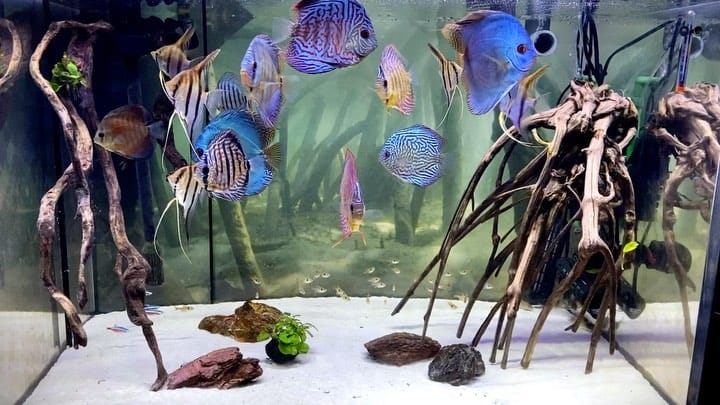
As mentioned above, there are cichlids that do well together and can be kept in a tank with other tank mates, regardless if they’re cichlid or non-cichlid species.
If you really want to have a cichlid community tank, these are your safest options.
- Angelfish (Pterophyllum sp)
- Ram Cichlids (Mikrogeophagus spp.)
- Bolivian Butterflies (Mesonauta festivus)
- Congo cichlids (Pelvicachromis pulcher)
- Banded cichlids (Heros severus)
- Krib cichlids (Pelvicachromis pulcher)
- Electric Yellow (Labidochromis caeruleus)
- Severums (Heros serverus)
- Agassiz’s Dwarf Cichlid (Apistogramma agassizii)
- Blue Acara (Aequidens pulcher)
- Discus Fish (Symphysodon genus)
- Keyhole Cichlid (Cleithracara maronii)
- Rainbow Cichlid (Herotilapia multispinosa)
Also Read:
- African Cichlid Tank Size & Setup Guide
- How Long Do Different Cichlid Species Live?
- 13 Ideal Tank Mates for Your Tiger Barb
- Best Oscar Tank Mates
FAQs
Can I Put African Cichlids and American Cichlids Together?
If you’re a beginner aquarist, we recommend only mixing cichlids that belong to the same region because it makes it easier to ensure that the tank has the right water parameters and conditions. American cichlids tend to have different requirements than African cichlids, so it’s best to keep them separate unless you know what you’re doing.
What Are Dither Fish for Cichlids?
Dither fish refer to fish that cichlids use as a “barometer” to gauge their environment and stress levels. These fish are usually small enough to avoid becoming cichlid meals, and they’ll act as a distraction to cichlids that are feeling territorial or aggressive.
What Is the Easiest Cichlid to Keep?
One of the easiest cichlids to keep for beginner fishkeepers is the Convict Cichlid. Although they’re considered aggressive, they’re also very hardy and can tolerate a wide range of water conditions, making them perfect for newbies to the aquarium hobby. However, it’s important that you keep them in a single-species tank until you gain more experience.
What Is the Most Aggressive Cichlid Species?
Many cichlid species are considered aggressive, but some of the most aggressive out there are the Central America-native Dovii Cichlid, its cousin the Jaguar Cichlid, and the Sieve Cichlid, which is simply a smaller version of the Dovii.
These species will not hesitate to bite other tank mates if given the chance, or to outright eat them if they’re small enough to fit in their mouths.
How Many Cichlids Can I Have in The Tank?
How many cichlids you can keep in your tank depends on many factors, such as what cichlids you have, the size of the tank, as well as how aggressive or peaceful your fish are.
Larger species, understandably, need more space to move, but aggressive species could also use the extra space in order to curb their aggression and allow them to establish their own territories within the tank.
Final Thoughts
Now you know what fish cichlids can live with, as well as which cichlids are better off in a tank by themselves. Remember, as fishkeepers, it’s our responsibility to provide cichlids with the best possible quality of life.
This means providing them with cichlid tank mates that won’t harm or stress them out, but will instead enrich their lives and possibly even form tight bonds with them. With this guide, hopefully, you can do just that!
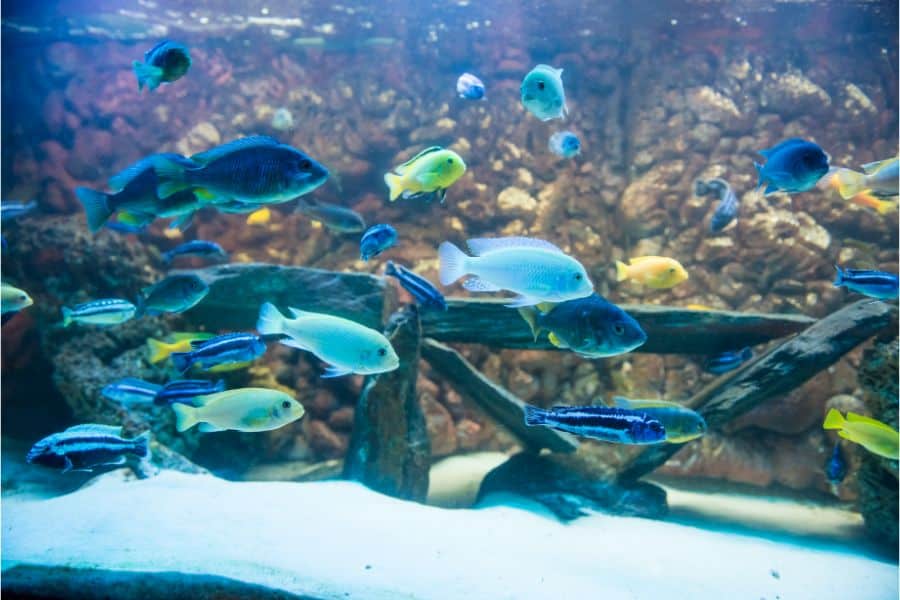
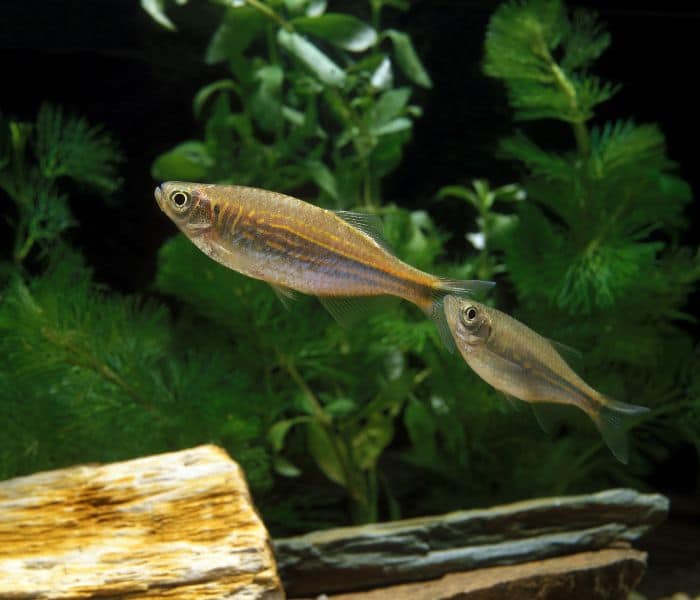
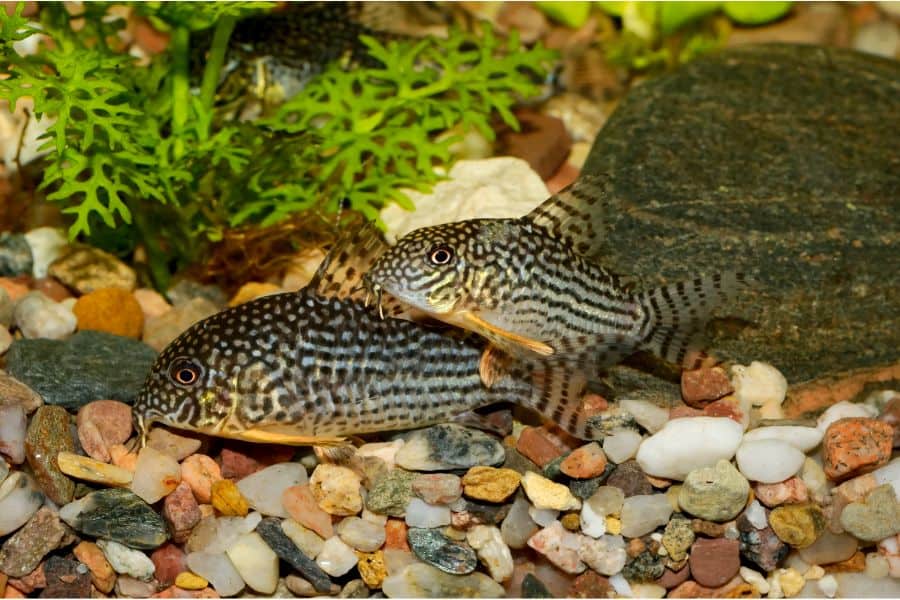
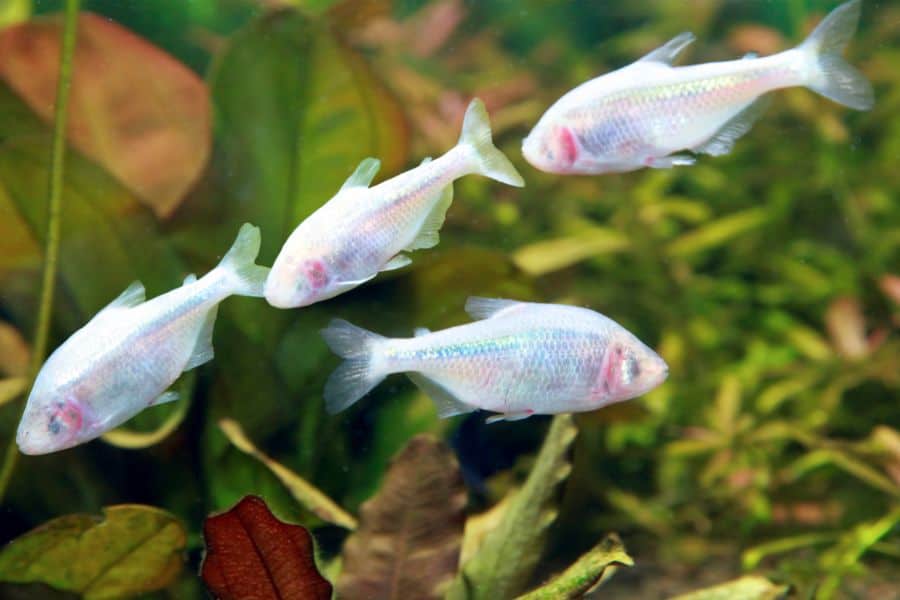
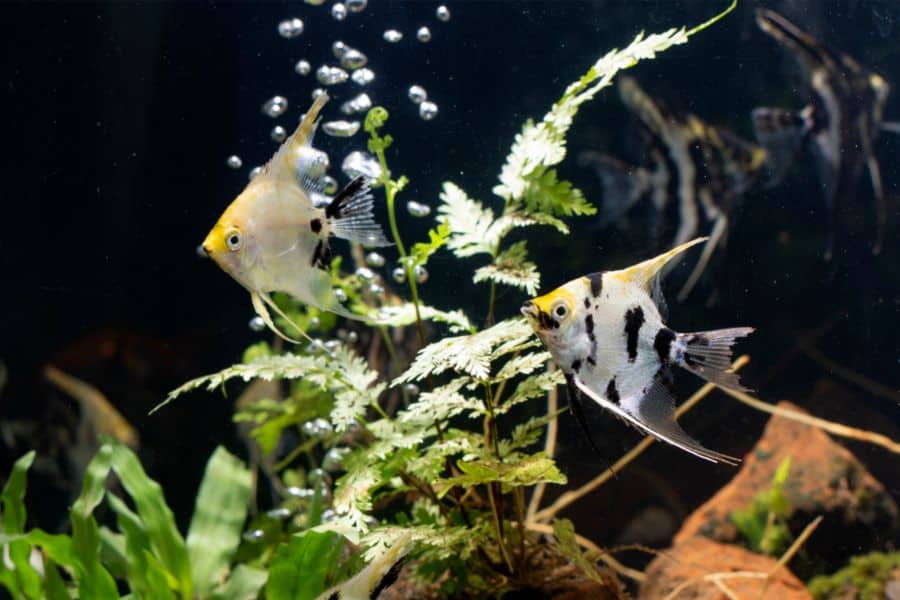
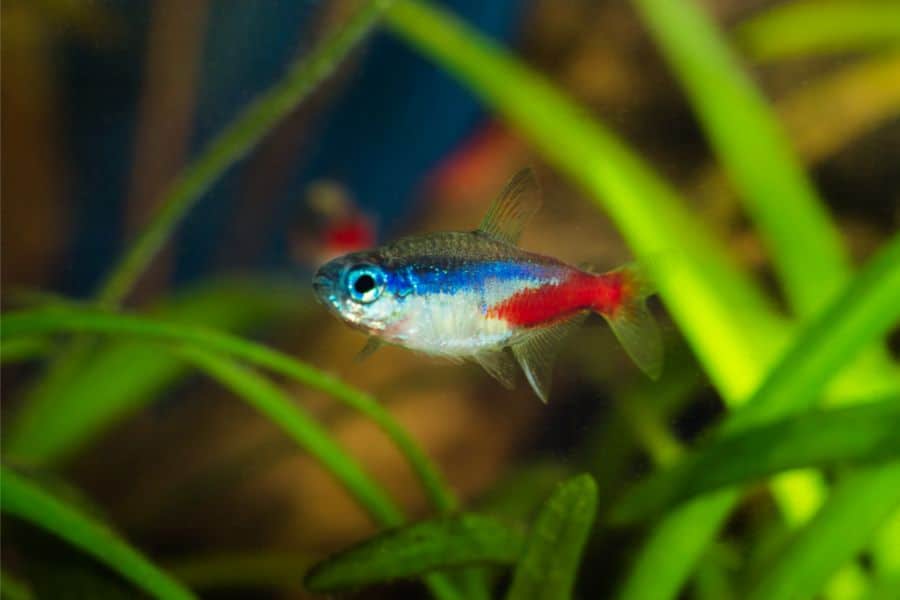
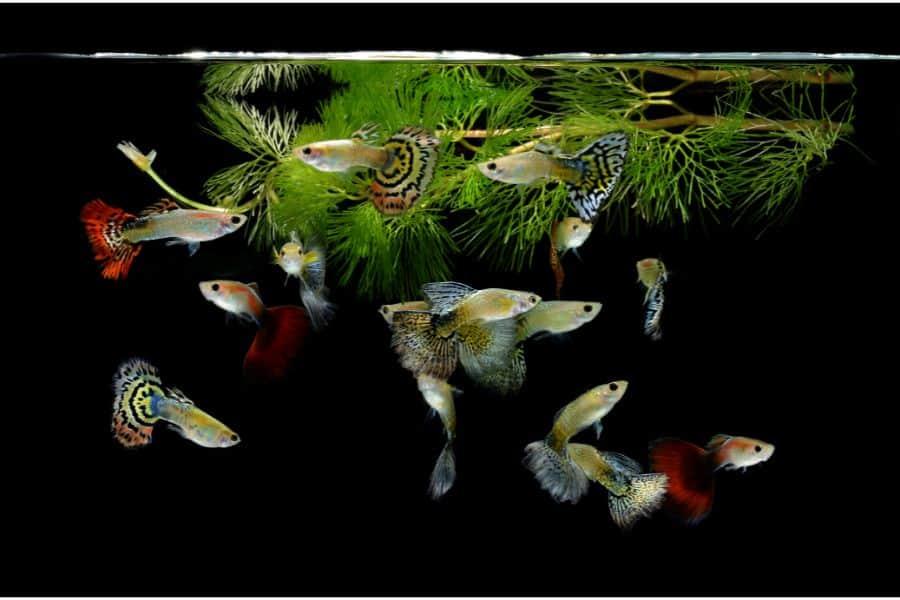
I’ve had fish and tanks for along time now. Learn something new about them everyday. Always interesting.
Thank you so much for this breakdown . I have been keeping Cichlids for over 45 yrs ,and this is one of most accurate breakdowns i have seen . It is dead on with the knowledge of different types temperment of fish .
We’re very happy to hear that! Our goal is to provide comprehensive guides for both beginner and advanced aquarists.